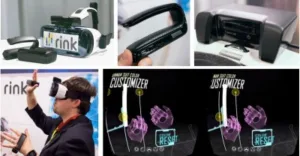Samsung Creative Lab is run by Samsung Corporation as an in-house incubator to let “company employees play with ambitious ideas and turn them into full-fledged startups.” Working at the CSL for a full year, a six person team headed by Yongjin Cho have developed a system that provides full 360º hand movements and finger tracking capability to the Gear VR headset, Samsung’s smartphone-based virtual reality platform. The system is called Rink.
The first component of the system is an emitter module that sits atop the Gear VR headset. The emitter creates a sensor bubble around the user in which there is no line-of-sight requirement. That is, gestures or movements outside of the direct field of view, such as down by the user’s sides or even behind their back, can still be detected.
The emitter communicates wirelessly with a pair of controller paddles that slip over the user’s hands. Although the paddles firmly grip the user’s palms, the user’s fingers are left free to move. Rink uses a combination of IR emitters along the edge of the paddle and a magnetic field to achieve positional and 360º gesture tracking.
To interact with objects in the virtual world, the user first clenches their fist to initiate the process. The system is then able to track the user’s fingers with a good degree of precision. In one embodiment, illustrated in the bottom right hand figure, the interaction is manifested by the appearance of a pair of virtual hands in the virtual environment.
With this capability, it is possible for the user to type on a virtual keyboard projected in mid-air by a virtual reality headset. The system, is claimed adequate for interacting with text messages, inputting email addresses or shortcuts in games.
A video illustrating the Rink in operation can be found at the end of this article.
It should be noted that, although Rink was demonstrated at CES in conjunction with a Samsung Gear VR headset, the system is actually not tied to any specific VR platform. That is, the emitter box can be mounted and work with any headset including Google Cardboard and Oculus Rift.
At this time, Rink is still a prototype and a good ways from being a consumer product. This status was demonstrated by some of the reports posted on line by people that experienced the demo at CES. It was reported that “movement was very rough and not very precise.”
None-the-less, the Rink system should have real commercial potential in that it seems to fill a vacant product niche. That is, although it might not be the best interface for every virtual reality application, it still represents an improvement on other existing interface devices such as joysticks and wands.
According to Cho, Rink’s future will depend on the “public reception of the device and how stakeholders within Samsung feel about the project. Samsung might decide to incorporate it into one of its own business units, or, alternatively, allow Cho to spin it out as a standalone concern.” –Arthur Berman

